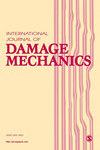初始各向异性沉积岩微裂纹连续损伤模型
IF 3.9
2区 工程技术
Q2 MATERIALS SCIENCE, MULTIDISCIPLINARY
引用次数: 0
摘要
本文针对沉积岩等初始各向异性岩石,提出了一种基于微裂纹的各向异性损伤模型。采用二阶损伤张量表示微裂纹的密度和方向。各向异性力学损伤演化规律由微裂纹的扩展决定。用局部拉应力和线弹性断裂力学来描述微裂纹的扩展。在损伤演化方程中还考虑了层理平面的方向。考虑了固有各向异性和诱导各向异性之间的耦合效应,建立了本构方程。模型参数可通过不同层理方向岩石的三轴压缩试验确定。该模型用于描述典型沉积岩的力学行为。实验结果与仿真结果吻合较好。该模型能够捕捉到初始各向异性岩石的一般各向异性行为和损伤特性。由于裂纹控制模型,在早期软化状态下的弹回行为也被捕获。本文章由计算机程序翻译,如有差异,请以英文原文为准。
A microcrack-based continuum damage model for initially anisotropic sedimentary rocks
In present work, a new microcrack-based anisotropic damage model is proposed for initially anisotropic rocks, such as sedimentary rock. A second-order damage tensor is adopted to represent the density and direction of the microcracks. The anisotropic mechanical damage evolution law is determined by the propagation of microcracks. Local tensile stress and linear elastic fracture mechanics are used to describe the propagation of microcrack. The orientation of bedding plane is also taken into account in damage evolution equation. The constitutive equations are developed by considering the coupling effects between the inherent and induced anisotropies. The model parameters can be determined by triaxial compression tests of rocks with different bedding orientations. The proposed model is applied to describe the mechanical behavior of a typical sedimentary rock. The experimental and simulated results are in good agreement. The model can capture the general anisotropic behavior and damage properties of the initially anisotropic rocks. Due to the crack-controlled model, snap-back behavior in the early softening regime is also captured.
求助全文
通过发布文献求助,成功后即可免费获取论文全文。
去求助
来源期刊

International Journal of Damage Mechanics
工程技术-材料科学:综合
CiteScore
8.70
自引率
26.20%
发文量
48
审稿时长
5.4 months
期刊介绍:
Featuring original, peer-reviewed papers by leading specialists from around the world, the International Journal of Damage Mechanics covers new developments in the science and engineering of fracture and damage mechanics.
Devoted to the prompt publication of original papers reporting the results of experimental or theoretical work on any aspect of research in the mechanics of fracture and damage assessment, the journal provides an effective mechanism to disseminate information not only within the research community but also between the reseach laboratory and industrial design department.
The journal also promotes and contributes to development of the concept of damage mechanics. This journal is a member of the Committee on Publication Ethics (COPE).
 求助内容:
求助内容: 应助结果提醒方式:
应助结果提醒方式:


